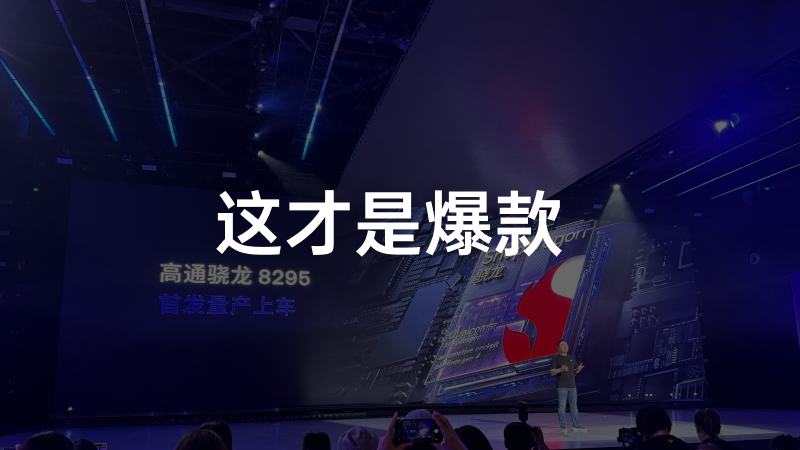In the second half of 2023, with the successively release of the new Benz Long Wheelbase E-Class, JIYUE 01, and ZEEKR 001 FR, the 5nm process chip was genuinely mass-produced in vehicles, represented by Qualcomm’s automotive-grade Snapdragon 8295.

At the Guangzhou Auto Show that ended last week, we observed that at least seven popular new models were equipped with this chip. Moreover, it’s conceivable that in 2024, Snapdragon 8295 will become a standard fixture in more vehicles that highlight technology and new experience features.
The updates aren’t just about the 5nm process. Paired with the Snapdragon 8295 comes absolute PC-level performance. In the cabin, 6K and 8K high-resolution screens have finally made their way into the vehicle. Even running major mobile games is stress-free. Bolstered by significant improvements in local AI capabilities, tasks that could only be done in the cloud can now be wholly executed locally – this includes hot AI models.
The Snapdragon 8295 chip is paving the way for the development of an even more all-rounder flagship cabin.
If you’re considering buying a car or aren’t well-acquainted with Snapdragon 8295, we’ll dissect the significance of this product for the industry and consumers, the advantages of the “new generation of vehicle-machine chip cap”, and how auto-companies leverage the enhanced chip performance to develop tangible upgrade experiences.
5nm Chip’s First Vehicle Debut
The mass production of Snapdragon 8295, can be called a major upgrade in the auto-chip industry: it’s the first vehicle-grade 5nm chip which marks the technical transition from 7nm to 5nm. This is currently the highest process technology experienced in mass-produced vehicles.
Excluding the third-generation Snapdragon 8 launched at the end of the year, that adopted the 4nm process, the process of this year’s top consumer-grade chips still operates on the 5nm node. The advanced process brings performance and energy efficiency improvements, indicating that as an automotive-grade Snapdragon 8295 chip, it leads the industry in technology and, more importantly, has strong performance.

Firstly, let’s look at the CPU. The Snapdragon 8295 carries Qualcomm’s sixth generation Kryo CPU, adopting a quad-core big core architecture. This design, distinct from mobile chips which focus on energy efficiency and heat emission commonly incorporating energy-saving small cores, the vehicle chip, with better space, cooling, and redundancy conditions, is more conducive to performance release, so it uses larger cores.
The Snapdragon 8295 chip CPU computing power can reach 230K DMIPS. By comparison, the CPU computing power of currently mainstream vehicle-machine chips are basically designed according to the 100K DMIPS standard; the computing power of Snapdragon 8295 is doubled.
Of course, Qualcomm’s all-new CPU architecture, Oryon, is already on the road. This new architecture is likely to be equipped in vehicles and other terminals by next year, bringing an even stronger CPU performance.
Looking at the GPU core for graphics processing, Snapdragon 8295 employs the sixth-generation Qualcomm Adreno GPU, capable of 2.9 trillion single-precision flops (2.9TFLOPS) or 5.8 trillion half-precision flops (5.8TFLOPS) per second. This performance level is not really on par with other mainstream in-vehicle chips, and is even superior to PC chips such as Apple M1’s GPU compute power of 2.6TFLOPS. Sitting between M1 and M2, Snapdragon 8295’s GPU performance is more than enough for mobile games.
Thanks to the stronger GPU performance and the addition of the DPU (Display Processing Unit), Snapdragon 8295 can support up to 32 screens, or up to six 4K screens– equivalent to nearly 50 million pixels.
In terms of AI abilities, Snapdragon 8295 has made a huge leap. Its computational power, even more exaggerated, is stronger than Apple’s latest flagship chip A17 Pro and surpasses the AI capabilities of many self-driving chips. The complexity of the interior interaction design and the expansion of in-vehicle use cases will enrich and add immersive elements to future cockpit functions.
In addition, the video processor (VPU), vision processing accelerator, security manager, and security processor and other cores, collectively constitute Snapdragon 8295. All in all, in Qualcomm’s cockpit chip products, the newest is the fourth-generation Snapdragon cockpit platform, with Snapdragon 8295 positioned as the ‘supreme’ level.

Since the performance is so strong, why not benchmark it? Antutu Car Edition recently released the benchmark score of the Mercedes-Benz long-wheelbase E-class vehicle, exceeding 930,000, doubling the benchmark data compared to mainstream in-vehicle chips. It’s essential to stress that the car edition benchmarks and phone edition belong to two systems, and their scores are not comparable. The benchmark score only represents theoretical performance; the real experience depends on the vehicular software tuning.
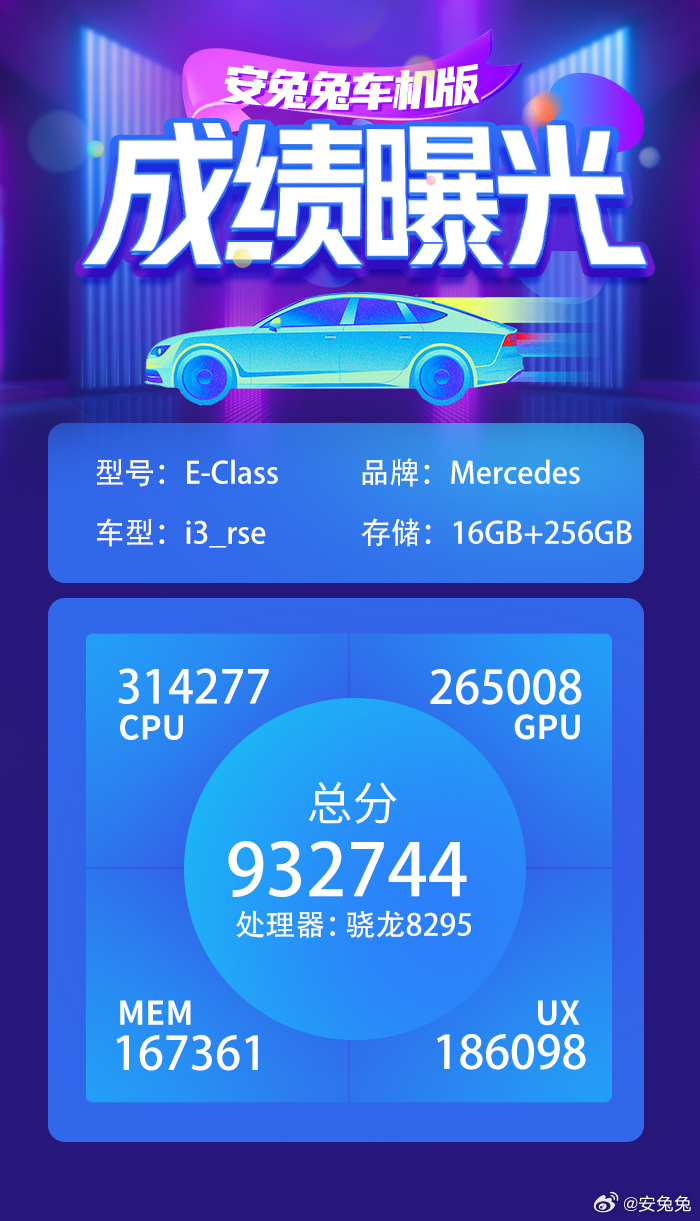
So, where will the powerful performance of Snapdragon 8295 come into play?
What can be done with such formidable performance?
Let’s go back to the initial stage of the smart cockpit when the big screen in cars was intended to replace mobile phone stands, revolutionizing navigation and audio-video experiences. Today, this goal has been basically achieved.The next stage of the intelligent cockpit is to transform into a computing center. With the basic experience in place, multimedia entertainment and gaming will become the next growth points, and what’s more important is that the intelligent experience requires a major upgrade. The foundation for achieving these application scenarios is stronger computing power.
Models featuring the Snapdragon 8295 are also planning around multimedia entertainment, gaming, and intelligent experiences.
High-resolution screen – the basis for more enjoyable entertainment and display
For in-car entertainment, the size and resolution of the screen are the basis for excellent display effects. It’s this higher demand for cockpit entertainment that brings high-quality screens into the car.
In the new long-wheelbase Mercedes-Benz E-class, a 12.3-inches instrument screen, 14.4-inches central control screen, and 12.3-inches passenger screen are introduced.
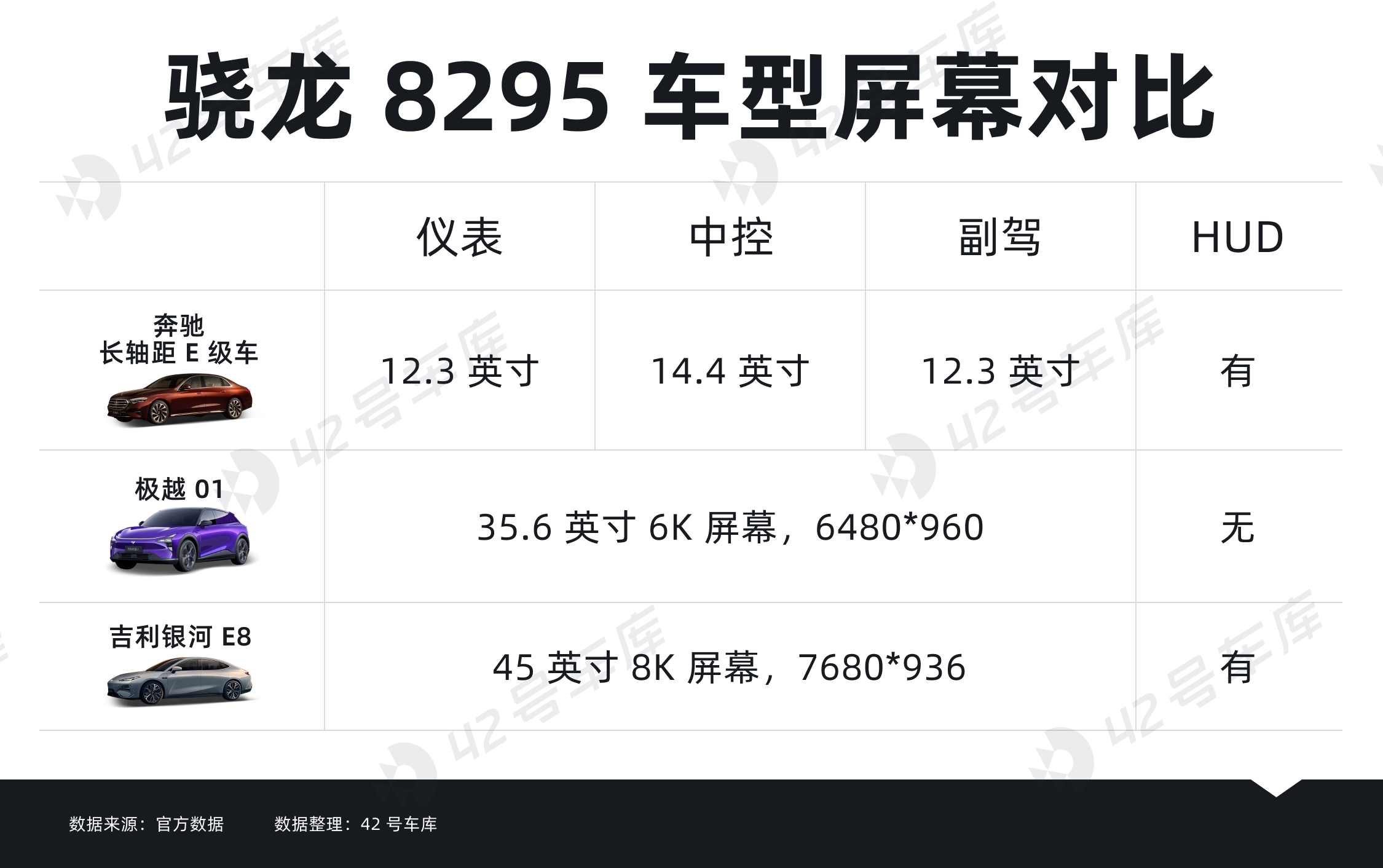
In JIYUE 01 and GEELY E8, the front screens have all become integrated and are not made up of multiple screens. The immersion is notably better. The JIYUE 01 vehicle interior screen has a horizontal resolution of 6K, the GEELY E8 screen has a horizontal resolution of up to 8K.
The substantial increase in the number of pixels means higher graphics processing pressure, and the Snapdragon 8295 is just made for such application scenarios; conversely, with a stronger foundation, automakers have more room for imagination.
Popular mobile games – the next growth point
The substantial increase in the performance of the vehicle machine chip is easily manifested in an application like gaming. Two years ago, Elon Musk added a chip equivalent to the PlayStation 5 to the Model S and X, precisely for heavier-loaded games.
At the time, many models supported in-car gaming by casting the screen or connecting external devices, but it wasn’t as direct as opening an App. Meanwhile, NIO has made customer connection via NIO Phone and dual Snapdragon platform end-to-end connection for NIO models the direction of development.
Today, a more powerful GPU is entering the car, preparing for an even better gaming experience.
In the JIYUE 01 vehicle machine, we can play Asphalt 9 full screen. With such a wide screen, the game perspective is very open, and together with the street views on both sides of the car, the immersive feeling of the game is several levels higher than with a mobile phone or tablet.
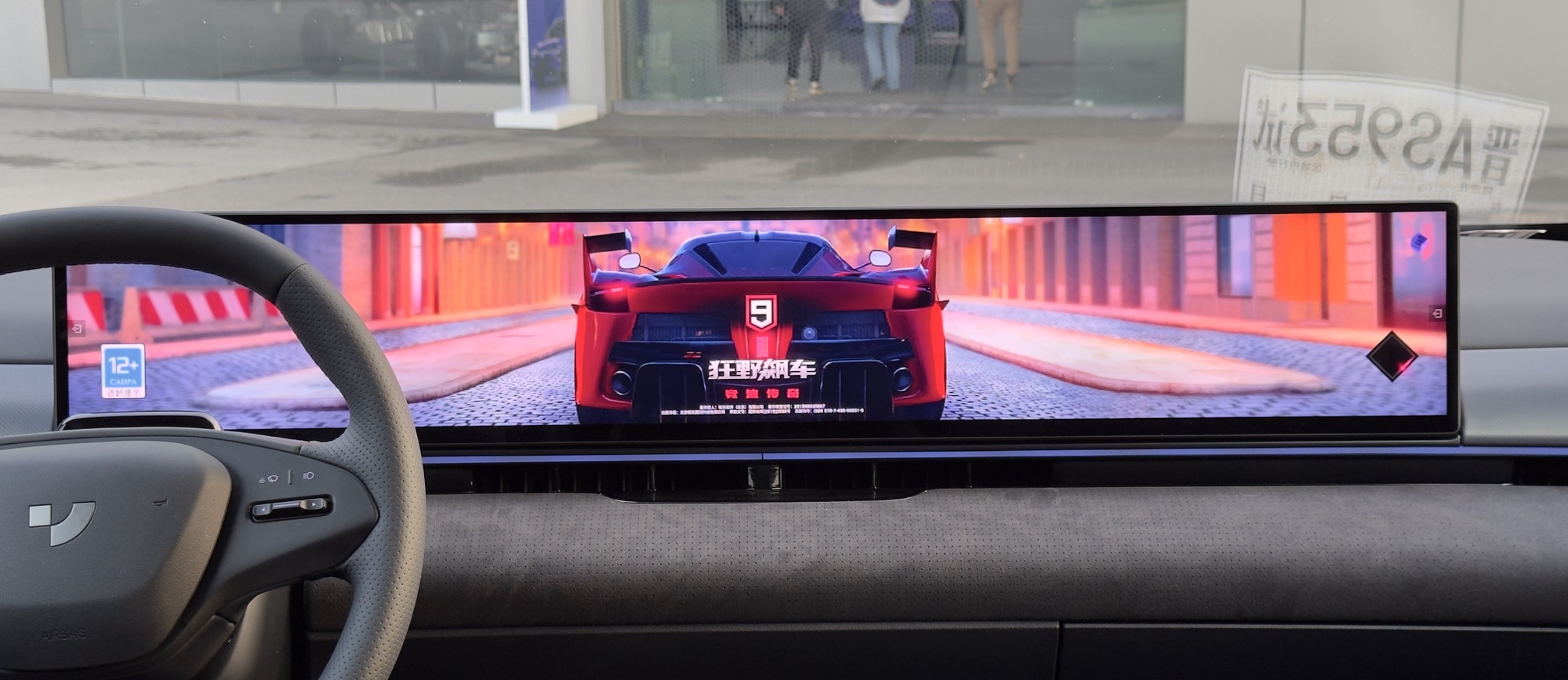
In the overseas version of the Mercedes-Benz E-class, users can play “Angry Birds” on the screen, marking the first collaboration between Angry Birds and a luxury car brand.
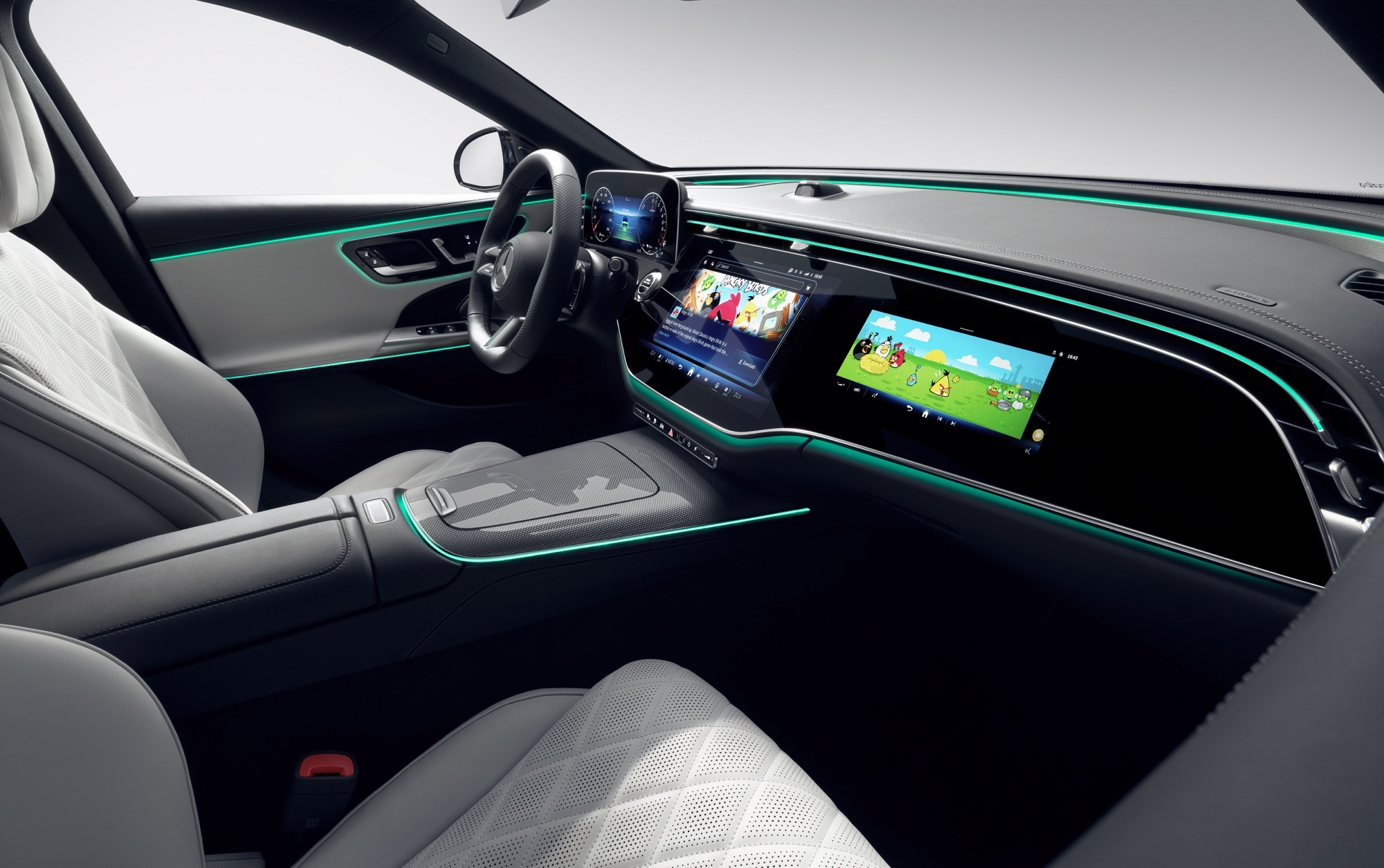 The release of the long-wheelbase Mercedes-Benz E-Class in the domestic market takes a step further, refinishing the navigation interface. Developed in collaboration with Unity China, Mercedes-Benz achieved a more detailed map rendering, along with real-time light and shadow effects, grassland animations, and water surface reflections. These effects require a more robust GPU performance, which the Snapdragon 8295 provides as a better option.
The release of the long-wheelbase Mercedes-Benz E-Class in the domestic market takes a step further, refinishing the navigation interface. Developed in collaboration with Unity China, Mercedes-Benz achieved a more detailed map rendering, along with real-time light and shadow effects, grassland animations, and water surface reflections. These effects require a more robust GPU performance, which the Snapdragon 8295 provides as a better option.
In essence, gaming alongside a more detailed UI design could become the next growth point within the domain of smart cockpits.
AI Makes the Cockpit Smarter
Over the past two years, generative AI has seen rapid advancements, and plenty of automakers plan to or have already incorporated extensive models into their vehicles. Priorly constrained by local AI computing power, these companies coordinated cloud-based and local computation— from basic voice recognition to complex AI models.
This setup stirred an issue. Once a vehicle was located in basements, tunnels, or any area with poor network coverage, tasks requiring cloud computing either suffered high latency or were directly inaccessible. The most effective solution was to transfer computational loads typically completed in the cloud to the vehicle, allowing for local completion.
In practice, the shift from cloud-based to local executions carries manifold improvements for user experience. Infotainment systems can quickly respond anytime, uninfluenced by network conditions, while local operations secure in-car privacy and pose no risk of data leaks.
At this point, a highlight on JIYUE 01 is necessary. After enabling two NPUs on the Snapdragon 8295, it achieved offline voice recognition completely. Official records demonstrate that JIYUE 01’s voice recognition speed clocks in at 500 ms, with voice response times within 700 ms. On average, most vehicles’ voice response time surpasses one second in practical tests, showcasing completely local voice capabilities do have a slight edge in terms of speed.
Granted, official results and actual test results may not be directly comparable. Nevertheless, we secured a JIYUE 01 production vehicle and will carry out further testing soon.
Barring voice capabilities, large AI models will shortly occupy vehicles. With the enhanced AI capabilities of the Snapdragon 8295, some models can be deployed locally, promising faster response times.
By harnessing the performance benefits of the Snapdragon 8295, various automakers are focusing their efforts on video and audio entertainment, gaming, and AI fields. In part, it is the performance advantages of the Snapdragon 8295 that provides intelligent cockpits with more substantial improvement in space.
For the next stage of smart cockpits, the evolution direction lies in experiencing a more capable cockpit and key functions exclusive to commuting scenarios. The mass production entry of the Snapdragon 8295 will expedite the evolution of smart cockpits.
‘Digital Chassis’ Empowers Smart Car Ecosystem
Whether they are century-old automakers or new entrants, intelligence and electrification are their core goals. Moreover, intelligent infrastructure is, in actuality, a chip. Concurrently, a single cockpit chip is far from sufficient. Qualcomm’s layout aims to provide ‘digital chassis’ for smart cars—intelligence solutions that permeate the entire system, starting from the vehicle’s foundational design.
Hence, the emergence of the Snapdragon digital chassis becomes the solution for in-vehicle infotainment, intelligent driving, connected vehicle technology, vehicle-to-cloud services, and more.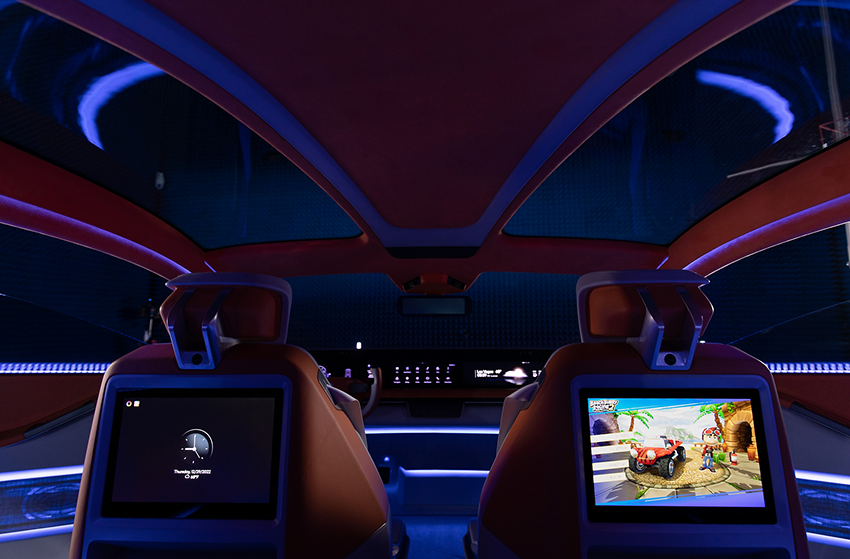
In the field of cockpit technology, the third-generation flagship of Snapdragon Cockpit Platform, Snapdragon 8155, which has achieved popularization earlier, has become the “standard configuration” for many car models. At this Guangzhou Auto Show, a variety of models, including the 2023 Camry, Buick ELECTRA E5 Pioneer Edition, Changan QiYuan A07, GuanQi M8 master, GuanQi New Energy E8, FORD Ranger, VOYAH pursuer PHEV, LOTUS EMEYA, MG Cyberster, HOZON X, new generation BMW 5 Series, Tank 700 Hi4-T launching limited edition, Wei Brand Lingshan DHT-PHEV, VOLVO EM90 and Xingjiyuan ES all carry this chip.
The fourth-generation Snapdragon cockpit platform has just been on the car, and nearly 10 models have been equipped with this generation of cockpit chips.
In the field of intelligent driving, Qualcomm also has a layout. In China, Great Wall Automobile uses Qualcomm’s Snapdragon Ride platform on its own cars through its autopilot company Momenta. After the combination of Snapdragon Ride SoC and accelerators, the Little Magic Box 3.0 platform built by Momenta achieves a single-board computing power of 360 TOPS, which can be continuously upgraded to 1440 TOPS. It is based on this platform that Momenta’s urban navigation assisted driving NOH is being implemented in many cities.
Data show that there are 250 million cars globally using Snapdragon Digital Chassis, among which, since 2021, more than 40 domestic car brands have launched more than 100 models using Snapdragon Digital Chassis solutions.
In overseas markets, brands such as FAW Audi, BMW, Buick, SAIC GM, and VOLVO have also launched a large number of models based on Snapdragon Digital Chassis. For example, Cadillac models using Qualcomm’s smart driving solution Snapdragon Ride platform have been released. Cadillac recently announced that its pure electric version of Escalade (ESCALADE IQ) will carry Snapdragon cockpit platform, Snapdragon auto intelligent alliance platform and Snapdragon Ride platform. By the end of next year, this car will be delivered. Other models equipped with Snapdragon Digital Chassis include VOLVO EX90. Compared with the current generation, the speed of EX90’s infotainment system doubles, and the graphics processing speed increases by 10 times.
Overall, in the automotive circle, where the inward spiral and innovation accelerate in 2023, it coincides with the uptake of new features such as 5G, AI and car mobile interconnection. Especially for car mobile interconnection, communication between multiple devices, computing power sharing, and ecological integration all rely on the support of underlying chips and development environments. Qualcomm, which has deep accumulation in multiple types of endpoints such as mobile phones and cars, may enable us to experience more possibilities in our riding experience in the future.
This article is a translation by AI of a Chinese report from 42HOW. If you have any questions about it, please email bd@42how.com.
